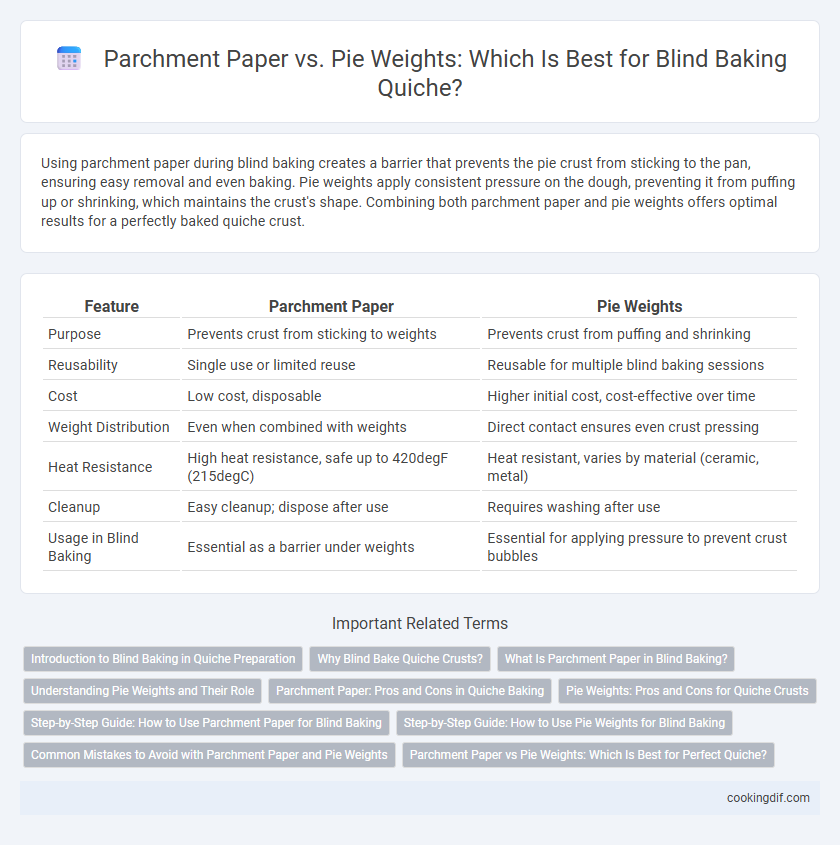Using parchment paper during blind baking creates a barrier that prevents the pie crust from sticking to the pan, ensuring easy removal and even baking. Pie weights apply consistent pressure on the dough, preventing it from puffing up or shrinking, which maintains the crust's shape. Combining both parchment paper and pie weights offers optimal results for a perfectly baked quiche crust.
Table of Comparison
| Feature | Parchment Paper | Pie Weights |
|---|---|---|
| Purpose | Prevents crust from sticking to weights | Prevents crust from puffing and shrinking |
| Reusability | Single use or limited reuse | Reusable for multiple blind baking sessions |
| Cost | Low cost, disposable | Higher initial cost, cost-effective over time |
| Weight Distribution | Even when combined with weights | Direct contact ensures even crust pressing |
| Heat Resistance | High heat resistance, safe up to 420degF (215degC) | Heat resistant, varies by material (ceramic, metal) |
| Cleanup | Easy cleanup; dispose after use | Requires washing after use |
| Usage in Blind Baking | Essential as a barrier under weights | Essential for applying pressure to prevent crust bubbles |
Introduction to Blind Baking in Quiche Preparation
Blind baking in quiche preparation involves pre-baking the crust to prevent sogginess when filled with a moist custard. Using parchment paper creates a non-stick surface that allows even heat distribution while protecting the dough, whereas pie weights maintain the crust's shape and prevent air bubbles during baking. Both methods ensure a crisp, golden crust essential for a perfect quiche base.
Why Blind Bake Quiche Crusts?
Blind baking quiche crusts prevents a soggy bottom by partially baking the crust before adding the filling, ensuring a crisp texture. Using parchment paper with pie weights distributes heat evenly and maintains the crust's shape without shrinking or puffing. This method is essential for quiche recipes with moist fillings like custards or vegetables, preserving the perfect balance of a flaky crust and fully cooked interior.
What Is Parchment Paper in Blind Baking?
Parchment paper in blind baking is a heat-resistant, non-stick sheet used to line pie crusts before filling to prevent direct contact with pie weights or dry beans. It helps maintain the crust's shape and prevents sogginess by allowing even heat distribution and easy removal of weights after baking. Using parchment paper reduces the risk of dough tearing and ensures a crisp, evenly baked quiche crust.
Understanding Pie Weights and Their Role
Pie weights are small ceramic or metal beads used to prevent the crust from puffing up and shrinking during blind baking, ensuring an evenly baked quiche crust. Using parchment paper as a liner between the crust and the weights prevents sticking and allows easy removal after baking. Proper use of pie weights maintains the quiche's structural integrity and results in a crisp, golden crust essential for a flawless filling.
Parchment Paper: Pros and Cons in Quiche Baking
Parchment paper offers a non-stick surface and easy cleanup when blind baking quiche crusts, preventing dough shrinkage by holding the crust firmly in place. Its lightweight nature ensures even heat distribution but may not provide enough weight to fully prevent bubbling compared to heavier pie weights. The trade-off between convenience and effective crust support makes parchment paper a practical choice for delicate quiche shells.
Pie Weights: Pros and Cons for Quiche Crusts
Pie weights ensure even heat distribution during blind baking, preventing the quiche crust from puffing or shrinking and maintaining its shape for a crisp, uniform texture. However, they require additional cleanup and can be cumbersome to handle compared to parchment paper, which is simpler but less effective at preventing crust deformation. For quiche crusts, using pie weights often results in a more professional and stable base, especially with delicate or buttery doughs.
Step-by-Step Guide: How to Use Parchment Paper for Blind Baking
Using parchment paper for blind baking a quiche crust helps prevent the dough from puffing up and ensures even cooking. First, roll out the pastry and place it in the tart pan, trimming excess dough. Next, lay a sheet of parchment paper over the crust, fill it with pie weights or dried beans, and bake at 375degF (190degC) for 15 minutes before removing the weights and paper to finish baking the crust until golden.
Step-by-Step Guide: How to Use Pie Weights for Blind Baking
Pie weights ensure even heat distribution and prevent the quiche crust from puffing or shrinking during blind baking. To use them, line the crust with parchment paper, fill it with pie weights, and bake until the edges are set, then carefully remove the weights and parchment for final browning. This method maintains crust shape and texture, critical for crisp, evenly baked quiche bases.
Common Mistakes to Avoid with Parchment Paper and Pie Weights
Using parchment paper without adequately securing it can cause it to shift during blind baking, leading to uneven crust edges. Overfilling the parchment with pie weights can result in dents or imprints on the quiche crust, compromising texture and presentation. Avoid reusing weights or papers multiple times, as residue buildup may cause burning or unwanted flavors in the quiche.
Parchment Paper vs Pie Weights: Which Is Best for Perfect Quiche?
Parchment paper provides a non-stick barrier that prevents the quiche crust from sticking while allowing steam to escape, resulting in a crisp and evenly baked shell. Pie weights, typically ceramic or metal beads, apply even pressure to the dough, preventing puffing and shrinking during blind baking for a uniformly flat crust. Choosing between parchment paper and pie weights depends on whether you prioritize ease of use and clean-up or precise crust shaping for a flawless quiche.
parchment paper vs pie weights for blind baking Infographic

 cookingdif.com
cookingdif.com